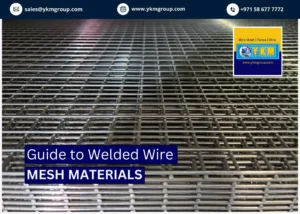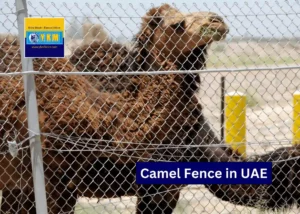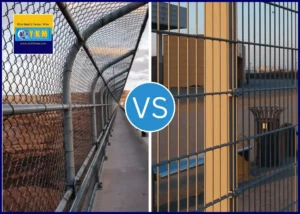Understanding what is Concertina wire or Razor Wire is indeed important to know the security it can provide. Concertina Wire commonly known as razor wire, is a formidable high security fencing material used for security purposes worldwide. It is comprised of a series of sharp, pointed blades arranged in a helical pattern, affixed to high-tensile wire. In this comprehensive guide, we will delve into what is concertina wire or razor wire, its origins, construction, applications, and safety considerations of concertina wire, shedding light on its significance in security installations and its widespread use in various settings.
What is Concertine Wire?
Concertina wire, also known as razor wire, is a type of fencing material made from galvanized steel wire with sharp barbs or razor blades interspersed along its length. It is designed to create a formidable barrier that is difficult to breach or climb over.
The term “concertina” refers to the coiled configuration of the wire. When not stretched or deployed, the wire is tightly wound in a spiral shape resembling a musical instrument called a concertina. This coiled structure allows for easy transportation and storage of the wire.
Why is it called concertina wire?
Concertina wire is named after the musical instrument called the “concertina,” which is a type of small accordion. The wire gets its name because of its appearance when it is coiled or stretched out.
When was razor wire invented?
Concertina wire originated in the late 19th century, initially serving as a material for military fortifications. It gained prominence during World War I and has since become synonymous with high-security fencing. Manufacturers typically produce concertina wire from galvanized or stainless steel, ensuring its durability and resistance to the elements.
The construction of razor wire involves a combination of sharp-edged metal strips, commonly referred to as barbs or blades, and high-tensile wire. The blades, typically made of steel, possess an extremely sharp edge and are challenging to manipulate or cut. The wire coils in a helical pattern, allowing it to expand and contract like an accordion, thus giving rise to the term “concertina wire.”
How is razor wire made?
To produce concertina wire, you will need to:
- Measure and cut the galvanized steel wire to the desired length. The length will depend on how long you want the concertina wire to be.
- Take one end of the wire and wrap it around a cylindrical object, such as a pipe or a drum, to create the circular shape of the concertina.
- Use pliers to twist the wire tightly around itself at regular intervals. This will create the coils of the concertina.
- Continue twisting the wire until you reach the other end. Ensure that the coils are evenly spaced and tightly wound.
- Once you have created the circular shape with tightly wound coils, cut the excess wire.
- Now, take the barbed wire and attach it to the concertina wire. Wrap the barbed wire around the outer circumference of the concertina wire, securing it at regular intervals.
- Ensure that the barbed wire is firmly attached and properly spaced to create sharp and effective barbs.
The main sizes are:
- 500mm / 0.5m / 50cm
- 750 mm / 0.75m/ 75cm
- 1000mm / 1.0m / 100cm
- The length is commonly 10m
What is the standard for Concertina wire?
Concertina or barbed tape divided into two main categories: Concertina Barbed Tape (CBT) and Barbed Tape Obstacle (BTO). These standards are:
1. CBT-60:
Barb size:
- Barb Length: 60.0mm
- Barb Width: 31.0mm
Tape Barb
- Thickness: 0.50mm
- Barb spacing: 100mm centre to centre
- Wire diameter: 2.5mm
2. CBT-65
Barb size:
- Barb Length: 65.0mm
- Barb Width: 21.0mm
- Barb Cut size :n/a
Tape Barb
- Thickness: 0.50mm
- Barb spacing: 100mm centre to centre
- Wire diameter: 2.5mm
3. BTO-30
- Barb size:
- Barb Length: 30.0mm
- Barb Width: 18.0mm
- Barb edge space: 35.0mm
Tape Barb
- Thickness: 0.50mm
- Barb spacing: 45mm centre to centre
- Wire diameter : 2.5mm
4. BTO-22
Barb size:
- Barb Length: 22.0mm
- Barb Width: 16.0mm
Tape Barb
- Thickness: 0.50mm
- Barb spacing: 35mm centre to centre.
- Core Wire diameter: 2.5mm
5. BTO-10
Barb size:
- Barb Length: 10.0mm
- Barb Width: 13.0mm
Tape Barb
- Thickness: 0.50mm
- Barb spacing: 25mm centre to centre
- Core Wire diameter: 2.5mm
6. BTO-12
Barb size:
- Barb Length: 12.0mm
- Barb Width: 15.0mm
Tape Barb
- Thickness: 0.50mm
- Barb spacing: 26.0 mm centre to centre.
- Core Wire diameter: 2.5mm
7. BTO-18
Barb size:
- Barb Length: 18.0mm
- Barb Width: 15.0mm
Tape Barb
- Thickness: 0.50mm
- Barb spacing: 33.0 mm centre to centre
- Core Wire diameter: 2.5mm
8. BTO-28
Barb size:
- Barb Length: 28.0mm
- Barb Width: 15.0mm
Tape Barb
- Thickness: 0.50mm
- Barb spacing: 34.0 mm centre to centre
- Core Wire diameter: 2.5mm
What is razor wire used for?
Razor Wire finds extensive application in a variety of security-related scenarios. Its primary purpose is to act as a deterrent, preventing unauthorized access and enhancing perimeter security. Here are some of the common applications of razor wire:
a) Military and Defence:
Concertina wire is widely used in military and defense installations to secure perimeters, safeguard military bases, and protect sensitive areas. It serves as a formidable barrier against intrusion, making it difficult for unauthorized personnel or vehicles to breach.
b) Prisons and Correctional Facilities:
Razor wire is a common sight in prisons and correctional facilities, where it is deployed to prevent escapes and enhance the security of the perimeter. Its sharp blades act as an effective psychological deterrent, dissuading inmates from attempting to breach the barriers.
c) Border Security:
Concertina wire is deployed along national borders to control and deter illegal border crossings. It provides an additional layer of defense, making it challenging for individuals to trespass or smuggle contraband across the border.
d) Industrial Sites:
Many industrial facilities, such as power plants, warehouses, and manufacturing units, utilize concertina wire to protect their assets and secure restricted areas within the premises. Its presence reinforces safety protocols and prevents unauthorized entry.
e) Temporary Security:
Razor wire is often used as a temporary security measure during events, protests, or civil unrest. It helps establish controlled perimeters and ensures the safety of participants and bystanders.
What are the Safety measures to be taken while using razor wire?
While concertina wire serves as a highly effective security solution, its installation and handling require careful consideration of safety measures. The sharp blades can cause severe injuries if mishandled or inadvertently touched. Here are a few safety guidelines to follow:
a) Professional Installation:
Concertina wire should be installed by trained professionals who are well-versed in the correct procedures. This ensures proper tensioning, alignment, and secure attachment to minimize the risk of accidents.
b) Warning Signage:
Clear and visible warning signs should be placed in areas where razor wire is installed. These signs alert individuals to the presence of a physical barrier and serve as a reminder to exercise caution.
c) Protective Gear:
When working with concertina wire, individuals must wear appropriate protective gear, including gloves, goggles, and sturdy clothing. This reduces the risk of accidental injuries and lacerations.
d) Maintenance and Inspection:
Regular maintenance and inspection of the razor wire are crucial to identify any damages or loose components. Prompt repairs or replacements should be carried out to maintain the efficacy and safety of the fencing system.
Concertina wire, or razor wire, has emerged as an essential component in enhancing security across various domains. Its robust construction, versatility, and effectiveness in deterring unauthorized access make it a widely adopted fencing solution. However, it is imperative to adhere to safety protocols during installation, maintenance, and handling to prevent accidents and injuries. With its continued use, concertina wire will likely remain a key element in safeguarding sensitive areas, protecting boundaries, and maintaining security in a wide range of applications.
About Us
YKM Group is the leading razor wire supplier in UAE and across MENA Region with over 40 years experince in manufacturing metal mesh with a dedicated Research and Development team. We have worked with numerous industries and have managed to supply optimal woven wire mesh based on industrial scenario.
Get Quote: [email protected]
FAQ (Frequently Asked Question)
Why is it called concertina wire?
Concertina wire is called so because of its resemblance to the bellows of a concertina musical instrument. The wire gets its name due to its appearance when it is coiled or stretched out.
What is razor wire?
Razor wire is a type of fencing material that consists of sharp-edged blades or barbs attached to a high-tensile wire. It is primarily used for security and perimeter protection purposes. Razor wire is designed to deter and prevent unauthorized access to restricted areas. Here are some key characteristics and uses of razor wire:




